Dental Sense for Dummies
Dental Sense for Dummies
Blog Article
Things about Dental Sense
Table of Contents6 Easy Facts About Dental Sense DescribedThe 6-Minute Rule for Dental SenseThe smart Trick of Dental Sense That Nobody is DiscussingUnknown Facts About Dental Sense
are medical devices operatively implanted into the jaw to bring back a person's ability to chew or their look. They provide support for artificial (fake) teeth, such as crowns, bridges, or dentures. When a tooth is lost as a result of injury or condition, an individual can experience issues such as fast bone loss, faulty speech, or adjustments to chewing patterns that result in discomfort.Dental implant systems consist of a dental implant body and oral implant joint and may additionally consist of an abutment fixation screw. Dental implants. The dental implant body is surgically inserted in the jawbone in place of the tooth's root. The oral implant joint is typically affixed to the implant body by the abutment fixation screw and prolongs with periodontals into the mouth to sustain the affixed man-made teeth
(https://dentalsense1.wordpress.com/2025/01/11/dental-implants-root-canal-procedures-professional-teeth-whitening/)Framework of The Oral Implant System choosing oral implants, speak to your oral company concerning the potential benefits and risks, and whether you are a candidate for the treatment. Points to consider: Your overall health and wellness is a crucial consider determining whether you are an excellent candidate for dental implants, for how long it will require to recover, and how long the implant may remain in area.
Smoking may impact the healing procedure and decrease the long-term success of the dental implant. The recovery procedure for the dental implant body might take several months or longer, throughout which time you commonly have a temporary abutment instead of the tooth. the dental implant treatment: Very carefully comply with the oral hygiene guidelines offered to you by your dental provider.
How Dental Sense can Save You Time, Stress, and Money.
Implant failing can cause the need for one more operation to take care of or replace the implant system. Recovers the ability to eat Recovers aesthetic appearance Assists keep the jawbone from reducing as a result of bone loss Preserves the health and wellness of the surrounding bone and gums Aids keep nearby (nearby) teeth secure Boosts quality of life Damages to bordering all-natural teeth during dental implant positioning Injury to the surrounding cells throughout surgery, such as sinus perforation Injury throughout surgery (for instance, crack of bordering jawbone) Insufficient function, such as seeming like the teeth do not bite together generally A feeling that the tooth hangs or twisting in position resulting from a joint screw loosening up Implant body failure (looseness of the dental implant body) as a result of systemic infection, which might be most likely in individuals with uncontrolled diabetes because of regional infection in bone and gum tissues sustaining the dental implant body due to delayed healing, which may be more probable in people that smoke Difficulty cleansing the gums around the dental implant, leading to bad dental health Neglected gum illness Post-surgical tingling as a result of nerve impingement or damages Always inform healthcare companies and useful content imaging professionals that you have oral implants before any type of magnetic resonance imaging (MRI) or x-ray procedures.
FDA is not aware of any type of damaging occasions reported for MRI or x-ray procedures with dental implants. Dental implants systems are typically made of products that adhere to international consensus requirements of the International Company for Standardization (ISO) or ASTM International. These criteria have details of what makes a secure product.

An oral implant is a structure that changes a missing out on tooth. With screw-like devices, the surgeon inserts a dental implant right into the jawbone, and it acts as an anchor for a man-made tooth, called a crown.
5 Easy Facts About Dental Sense Shown
Some individuals are not qualified for dental implant surgical procedure. It is for dental surgeons to run on people with: acute illnessuncontrollable metabolic diseasebone or soft tissue illness or infectionIf these issues are settled, an individual can have the surgery. In, dental surgeons abstain from operating people with: If individuals with any one of the above undergo dental implant surgical procedure, there is a higher danger of the implant failing.

Dental implant surgical procedure is a tailored procedure. It's not the same for every person. Yet the adhering to provides a general introduction of what you can expect your dentist, dental cosmetic surgeon, periodontist or prosthodontist to do: Put the implant operatively. Give you time to recover. Connect the message and last crown, bridge or denture.
Next off, your specialist will very carefully place the dental implant right into your jaw. Your doctor will rearrange your gum tissues and close the cut with stitches. If your dental implant is near the front of your mouth, your dental practitioner will certainly make a temporary tooth for you to wear till you heal. This way, you will not have a space in your smile while you recoup.
Not known Facts About Dental Sense
Your supplier can inform you what to anticipate in your scenario. Throughout the recovery stage, your jawbone needs to fuse to the oral implant. This process, called osseointegration, is vital for stability and long-term success. This process can take anywhere from three to nine months. In many cases, it might take much longer.
When your implant heals, your dental professional can affix the joint (little port post) and your last repair (crown, bridge or denture). This generally takes about one hour to complete and might need a second small surgical treatment. You should not really feel any pain throughout your dental implant treatment since your supplier will certainly use medicine to numb your gum tissues.
Report this page